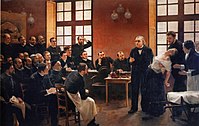
Photo from wikipedia
Abstract Investigation of reaction mechanisms by identifying the intermediates released into the gas phase is most effective at low conversion of reactants, ideally approaching zero. However, conversions below 0.5–1% are… Click to show full abstract
Abstract Investigation of reaction mechanisms by identifying the intermediates released into the gas phase is most effective at low conversion of reactants, ideally approaching zero. However, conversions below 0.5–1% are rarely used, due to the difficulty of analysis of low-concentration products. The mechanism of the title reaction is a subject of long-term discussion. We studied the mechanism using an original ultralow conversion (ULC) method. The idea is to perform the analysis of products after their preliminary accumulation in a suitable absorbent at the reactor outlet. This allows decreasing conversion by 2–3 orders of magnitude. The ULC experiments were conducted with a Bi–Mo catalyst at 100–250 °C and with propene conversion down to 0.001%. A new so-called allyl hydroxylation mechanism was revealed. A key step is the hydroxylation of the CH3 group to form an allyl alcohol intermediate, which is further oxidized to acrolein. The mechanism explains all reaction features and was confirmed by experiments at 350 °C.
Journal Title: Journal of Catalysis
Year Published: 2018
Link to full text (if available)
Share on Social Media: Sign Up to like & get
recommendations!